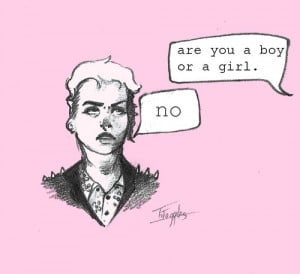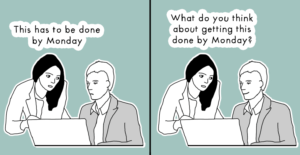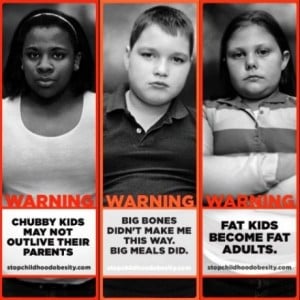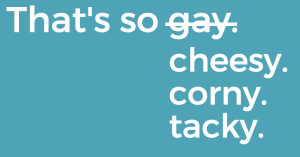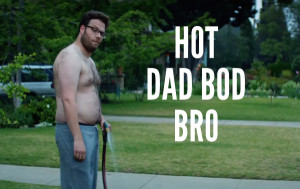
Source: 8bit Dad
The Dad Bod.
You’ve read about it on Tumblr. You’ve seen the gifs on Buzzfeed. And now you’re reading about it on your favorite news website.
This newest form of disgusting, blatant sexism is off to the races – and just who does it oppress? Well, in about ten years, it’ll be oppressing the girls currently buying into it. And not just them.
There are a lot of people who will be affected by all of this talk about the Dad Bod – and not just people who are annoyed by the fact that our 24 hour news cycle has nothing better to do than talk about an Internet meme.
So, first, a definition:
The “Dad Bod” was made popular in a now-viral article by a 19-year-old college student, although apparently it’s a term that’s been floating around in the cultural lexicon at the tail end of the millennial generation for some time now.
In short, the Dad Bod is the fetishization of the slightly doughy dude body. You know, “a nice balance between a beer gut and working out.”
If you need a visual example, there are plenty pictures of Leonardo DiCaprio, Adam Sandler, and Seth Rogan being showcased next to the recent headlines as shining examples of the type.
The Dad Bod could be seen, in some contexts, as a step in the right direction. After all, by its mere existence, it de-fetishizes the Men’s Health-inspired paradigm of six-pack abs for all men – and, potentially, it aids in alleviating the burden on many burgeoning, hidden male eating disorders. Which is great.
But there is also a seriously sinister, overtly sexist, body-policing overtone to this whole cultural phenomenon.
And we need to talk about it.
1. The Dad Bod vs. the Mom Bod
While we’re on the subject of the Dad Bod, can we talk about the Mom Bod? Oh—wait. We’ve been talking about it for years.
What’s the Mom Bod, you ask? Ah, well, if you ask the media, it’s cissexist concoction about how pregnancy happens and who it happens to that prizes perfectly toned, supple and elastic-skinned, back-to-six-pack-six-weeks-after-baby bodies.
The Mom Bod is the complete erasure of pregnancy as soon as the baby is out of your body – and the concept does this gross conflating of “motherhood” with “giving birth” thing.
Now, I’m sure that there will be (and already are) a million articles in response to this Dad Bod trend specifically pointing out the disgusting and unfair disparity between the way we talk about and police aging bodies based on gender, so I won’t harp on this too much.
Except to say this: What. The fuck.
And this:
If some people get permission to not be perfect as they age, then I opt out of a culture that refuses to offer that same permission to all people – particularly those whose body literally contorts to grow and then push out a living being.
Okay. Rant over. Or maybe it’s just beginning.
2. Self-Subjugation of Teenage Girls
Let’s talk about the things the media is not already talking about.
The Dad Bod phenomenon was not started by the media, even if it’s being publicized and spread by it now.
The Dad Bod phenomenon was started and popularized by…teenage girls.
And according to the original viral article, the Dad Bod phenomenon is less about the fetishization of men’s bodies, and more about the self-policing of women’s bodies.
Specifically thin women’s bodies.
The article – again, written by a teenage girl – claims that the reason why girls love the Dad Bod is that it makes girls feel thinner and prettier.
These young ladies’ insecurities about being seen next to a fit guy are so strong that they want a man with a Dad Bod not because they’re attracted to it, but because they want to be seen as more attractive in relation to it.
There is so much pressure on the teenage girl (and on women in general) to be a certain size and shape as they age that it’s no wonder that they have completely internalized the external body policing and found yet another way to self-police.
We can conceptualize the Dad Bod as just another diet trend, only in this case, the “diet” doesn’t involve food. The only rules of this diet? Make sure you’re dating a big guy, because “the bigger the guy, the smaller you feel.”
That’s an actual quote.
And so is this: “Men, confidently strut that gut on the beach because while you stare at us in our bikinis, we will be staring just as hard.”
While it probably seems like a “cute,” trendy, and innocuous fad, the fact of the matter is that the Dad Bod reveals exactly how prevalent and viral self-policing in the pursuit thin privilege is, even at young (and still very impressionable) ages.
It also reveals the competitive nature of internalized misogyny.
Women and girls are taught not only to compete with one another, but also to compete with themselves.
The pursuit of thin privilege is not just to be thin, but to be the thinnest (or leanest or strongest – whatever words you’re using to describe this same phenomenon).
The Dad Bod gives women one more way to measure their own worth by continuing to reduce their own perception of size of their bodies – and to perform that reduction in front of others, including in their intimate relationships.
Just as thousands of college aged girls put themselves on massively restrictive diets and take on grueling fitness challenges, there’s a new way to self-police and “build self-esteem” while tearing themselves down.
“You have to stay thin, but also find a guy whose gut will complement your bikini for the next 20 years,” this thought process goes. “You’re only as good as the man sitting next to you, ladies.”
It’s better than the South Beach Diet or hCG: not only do you get to watch your guy eat his cheat meal, but his pizza will make you look and feel better – no extra calories required for you!
3. The Dad Bod Is Body Policing Everyone
But honestly, the Dad Bod affects everyone.
Not only is it a sexist nightmare for women, but it’s also enforcing an overall paradigm of privilege versus body shame.
The thing is, men who have a Dad Bod still look like they work out. The article makes it clear that they’re not “an overweight guy.” So while the article seems to be liberating men from their “Bros Who Lift” body requirements, it’s still requiring that men, to be considered “attractive” don’t “let themselves go” too much.
(Aside: “Don’t let yourself go” is just a way to body shame fat people while reinforcing thin privilege because it implies that only thin[ner] people care about their health, have willpower, and can validate their feelings of self-worth through self-care.)
The Dad Bod may be much more attainable and maintainable than a Mom Bod is (according to our culturally accepted standards), but it’s still a body that excludes those who cannot attain it.
The pictures of people inside of a Dad Bod are mostly the same: white, privileged bodies – people who can afford their weekend warrior gym membership and their beer and pizza.
But what about people who are in other economic classes? Where are the multicultural bodies? What about endomorphic people with different body structures (or that matter, ectomorphs)? Where are the queer people? Where are the people with metabolic damage or thyroid issues? And on and on and on.
These are the same questions many of us have been asking about representation of women (and need to keep asking, unfortunately, because no one seems to be producing a good answer).
But before we embrace the Dad Bod as a step forward for mankind, let’s stop and consider what it says about the rest of the men who can’t or won’t have one.
In a way, we can liken this whole trend to the “real woman have curves” and “strong is the new skinny” messages that we see now being marketed to women through ad campaigns and fitspiration memes.
By “liberating” men from having to fit one stereotypical body, we place them in a new restriction without ever opening up the possibility in which many types of bodies (or, better yet, all types of bodies) are “allowed” or “okay.”
***
The fact that this trend even started and has now gone viral is so worrisome – because it’s just indicative of the fact that our culture is obsessed with body policing. We are over saturated with messages about how we’re supposed to look – all of us.
And we need to stop.
We need to ask our media to stop perpetuating these ridiculous body paradigms. We need to be educating our children to stop looking at bodies as a canvas on which to paint cultural expectations. We need to give ourselves permission to have our bodies, whatever they look like, and to exist inside of them with confidence, purpose, and love.
Now, that’s a body trend I can get behind.
[do_widget id=”text-101″]
Kaila Prins is a Contributing Writer for Everyday Feminism and a health coach who works with women who are ready to stop “recovering” from disordered eating and start “discovering” their true identities. Kaila’s health coaching services, as well as her blog, can be found at In My Skinny Genes, and she hosts a weekly podcast called Finding Our Hunger. She also counts characters and not calories on Twitter @performingwoman.
Search our 3000+ articles!
Read our articles about:
Our online racial justice training
Used by hundreds of universities, non-profits, and businesses.
Click to learn more







